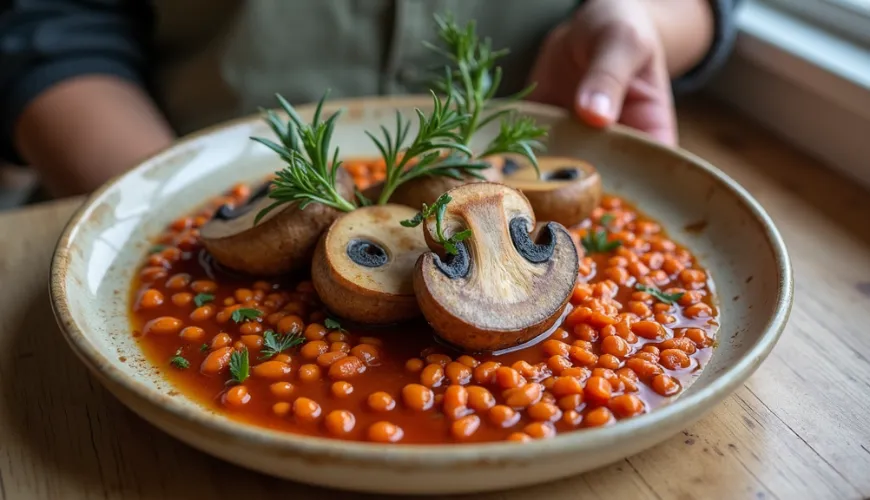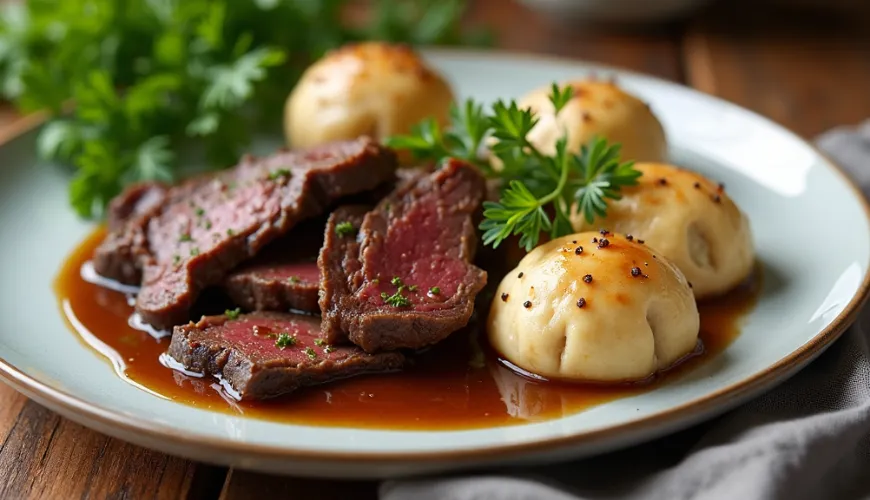
A recipe for classic beef steak brings a taste of nostalgia

Classic Pot Roast – A Recipe That Never Goes Out of Style
Some dishes have the power to transport us back in time. Just the aroma wafting from the kitchen can remind us of Sunday lunches at grandma’s, where the table was laden with hearty Czech meals. One such dish is undoubtedly the classic beef pot roast, which, despite changing trends in gastronomy, holds its rightful place on the plate. Although today we often look for vegetarian versions of traditional recipes and seek more sustainable options, pot roast remains a symbol of honest home cooking.
Its preparation is not complicated, yet it requires time and care – and these are the ingredients that make the difference between an ordinary and an exceptional meal. The pot roast recipe is proof that even seemingly simple ingredients can create a flavor-rich dish that will captivate every lover of Czech cuisine.
What Does “Pot Roast” Actually Mean?
The word “roast” comes from the designation of a part of the beef leg or low sirloin – that is, meat ideal for braising. In classic Czech cuisine, pot roast most often refers to slices of beef braised in a sauce with vegetables and spices, served with potatoes, rice, or bread dumplings. There are also variations with mustard, bacon, or even pickles.
In recent years, the recipe for classic pot roast has begun to reappear in households that strive to return to traditional and honest meals. It’s not a quick meal, nor is it entirely “fit,” but it definitely has its place on the table – whether it’s a weekend lunch, a festive feast, or just a desire to recall the cooking of our grandmothers.
The Key is Quality Meat and Patience
One of the key elements on which a good pot roast stands is the quality selection of meat. Ideal are slices from the low sirloin or possibly from the leg. The meat should be well-aged, tender, and with fine fat marbling, which melts during braising and adds juiciness to the dish. If you’re unsure about the selection, don’t hesitate to consult at the butcher's – traditional recipes deserve a traditional approach.
Equally important is time. Pot roast is not a meal prepared in twenty minutes. Slowly braised meat with onions, garlic, mustard, broth, and spices creates a sauce that becomes more intense and balanced in flavor with each minute of braising. And that’s the magic of pot roast – no complicated techniques, just time, patience, and honest ingredients.
Recipe for Classic Beef Pot Roast
To remind yourself of the taste of childhood, here is one of the proven recipes that works for generations:
Ingredients
- 800 g beef sirloin or leg
- 2 large onions
- 3 cloves of garlic
- 1 tablespoon full-fat mustard
- 1 tablespoon all-purpose flour (optional for thickening)
- 500 ml beef broth
- 1 teaspoon sweet paprika
- salt, pepper, bay leaf, allspice
- oil or lard for searing
Instructions
Slice the meat, lightly pound it, season with salt and pepper. Heat fat in a pot and briefly sear the meat on both sides until golden, then set aside. Sauté finely chopped onion in the drippings until golden, add garlic and paprika, and briefly sauté. Return the meat to the pot, add mustard, bay leaf, allspice, and pour in the broth so the meat is almost submerged. Cover and braise on low heat for about 1.5 to 2 hours until the meat is tender.
At the end, you can lightly thicken the sauce with flour mixed in a bit of water. Let it simmer for a few more minutes, season with salt and pepper as needed.
Traditionally, pot roast is served with rice, potatoes, or bread dumplings, but it tastes just as good with whole-grain pasta or millet if you’re looking for a healthier option.
Pot Roast in a Modern Take? It’s Possible Sustainably
An interesting trend in recent years is the effort to preserve traditional flavors while thinking about their environmental impact. Cattle farming has a significant impact on the environment, so many households are looking for alternatives – whether in the form of plant-based substitutes or in the selection of meat from organic farms.
For example, there is a version where tempeh or roasted celery is used instead of beef, braised in a sauce similar to the classic pot roast. The taste is, of course, not identical, but the texture and overall impression are surprisingly close. For those who want to maintain the flavor experience while reducing meat consumption, it’s a very interesting path.
Another option is simply to buy meat from verified organic farms, where ethical approaches to animal husbandry and more sustainable operations are emphasized. Yes, it’s more expensive, but if the pot roast is prepared only occasionally, it’s worth investing in quality.
Remember That Feeling When the Sauce Soaks Into the Bread Dumpling?
Food has the ability to evoke emotions, memories, and stories. Pot roast is not just a dish; it is a part of Czech culinary identity that connects generations. Who doesn’t recall Sunday lunches when the aroma of braised meat filled the kitchen, grandma stood at the stove, and a brown sauce glistened on the plate? These moments make recipes immortal.
When pot roast is prepared in the kitchen today, it’s far from just about satisfying hunger. It’s a ritual – slow, calm, careful. And even though there is more talk today about quick cooking, meal-prep boxes, and low-calorie recipes, some classics simply have the right to remain as they are.
As the renowned chef and promoter of Czech cuisine Roman Vaněk says: “When we give food time and love, it rewards us in taste.” And with pot roast, that holds doubly true.
So next time you’re wondering what to cook for Sunday – why not try the classic pot roast? It might remind you that the best meals aren’t the most modern, but those that carry a piece of home.

